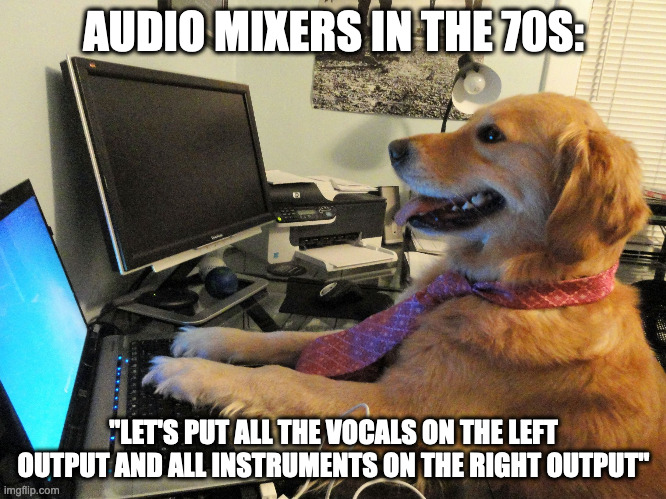this post was submitted on 07 Sep 2024
700 points (98.2% liked)
Memes
45162 readers
2834 users here now
Rules:
- Be civil and nice.
- Try not to excessively repost, as a rule of thumb, wait at least 2 months to do it if you have to.
founded 5 years ago
MODERATORS
you are viewing a single comment's thread
view the rest of the comments
view the rest of the comments

Turns out early audio consoles with stereo didn’t have a pan knob. They had a pan switch. So choices were limited to left, right, or center (mono).
Wasn’t til later that the pan pot was invented allowing incremental panning and true stereo mixing.
I mean this is true but not about the '70s as the original post states. Even by the '60s they had sophisticated stereo audio mixers - they just cost hundreds of thousands of dollars instead of running on people's phones like today.
Yeah, we had stereo mixing/mastering pretty much down by the 70s I think...
What I think OP might be referring to are albums that were recorded in mono in the 60s, and then released again in stereo in the 70s when the tech only allowed for full L or R panning. Those albums were never meant to be listened in anything but mono though.
Thank you, that's the piece of info I never had. If it's not a Reddit-level fact. The 2 channels were new and people wete trying things out and mind-altering substances were freely available as well, so judgment might have been hogtied at times.
At the time, there was sentiment that it was a way to sell two amplifiers and speakers instead of one, a suspicion furthered by the later arrival of quad, which for many was a bridge too far. Audio places tried that briefly and then went back to selling stereo. And may be why a certain generation looks askance at 5.1 etc.
There were other changes as well, tubes/valves to solid state plus hybrids...when I read about Cloud products in IT, it rhymes, marketing hoodoo inveigling into genuine tech appraisals.
It’s an incorrect comment based on a real thing.
There was equipment with switched panning, but knob panning was so common it was referenced in diy electronic project books aimed at high schoolers.
There are some tube amplifier circuit types where the pan control actually changes directly what signal goes to what grid of what tube, and in those cases it would be useful to have switch instead of pot pan, but there were circuits to mitigate the problems and even tubes intended to take multiple grid inputs by that time.
Another comment explained how a person could work around that problem and get pot pan with split channels and they’re right.
One of the biggest reasons for switched panning was that it wasn’t always clear that you were going for a stereo effect! Often in the case of reinforcing a live band, you had some speaker cabinets for different frequencies and it would be stupid to send the trumpets to the big cabinet meant for the tympani!
Partial panning was also used in lots of the movie versions of stereo and multi source sound from over a hundred years ago so it’s not like switched panning was the only option or something
Switched panning is famously present on mastering machines though for the old (er than single groove stereo) two groove stereo record type.
So switched panning isn’t the reason for the wild mixing of the 50s and 60s, but it did exist.
Thank you, helpful.
There weren't crossovers for routing signal in live recordings?
In my youth I wanted to learn more about this stuff, but I appeared to be much younger than I was, so was shooed away.
to be 100% clear, i was talking about using a mixer to run sound to make a live band sound bigger, not to record them, but yeah, to this day lots of live sound cabinets are without crossover.
who needs em when there's a qualified technician with several amplifiers setting everything up and running the board?
That's wild. But theoretically they could make two separate mono tracks, right? For example, a left mono track with 75% of what would have been an isolated left channel + 25% of the right channel and, similarly, a right mono track with 25% of what would have been an isolated left + 75% of the right. Then, sure, pan switch it fully to left and right.
You have to understand that mixing consoles from that era were supremely limited in channels (think four, eight, later sixteen), to the point where they would often have to mix one section (say, the drums) and then record that mix to tape so it would take up a single channel and then do the guitar, bass, and vocals on another channel. The idea of having two of the same thing going through two channels was an exorbitant luxury they couldn't afford!
That's even more complicated.
Exactly. Plus the common use of mastering at the time was to optimize the recorded audio for printing on a vinyl disc, and if the grooves were too deep or the transitions too sharp it could cause the needle to skip out of the track.
If your average listener is going to be listening on a mono device then a smart thing to do would be to pan one thing consistently to one side and the other to the other as the mono needle isn't going to care where it's getting its vibrations from. That would give you more resolution and more depth for the cut, as long as the final disc was only played in mono.
I'm not saying that's the case for every recording but I'm pretty sure it has happened quite a few times back then while they were still figuring everything out.